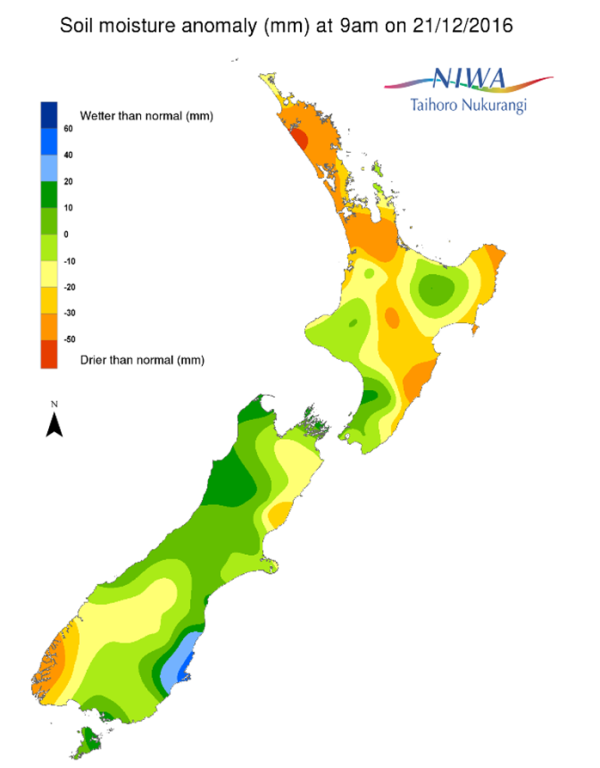A weekly update describing soil moisture across the country to help assess whether severely to extremely dry conditions are occurring or imminent. Regions experiencing these soil moisture deficits are deemed “hotspots”. Persistent hotspot regions have the potential to develop into drought.
Facts: soil moisture
Across the North Island, soil moisture levels have decreased almost everywhere during the past two weeks. The most substantial decreases were observed in Northland, Auckland, northern Waikato, and the Coromandel Peninsula. Smaller decreases also occurred in the Wellington region, southern Manawatu-Wanganui, and much of Taranaki. Meanwhile, small increases in soil moisture levels were observed in western Bay of Plenty and the East Cape. The driest soils across the North Island compared to normal for this time of the year are found in the Far North, while the wettest soils for this time of the year are found in small areas of western and central Bay of Plenty. Hotspots are now in place across nearly the entire eastern coast of the North Island, the Coromandel Peninsula, far northern Waikato, Auckland, and all of Northland. In fact, soils in the Coromandel Peninsula, Auckland, and Northland are extremely drier than normal.
Across the South Island, soil moisture levels have generally decreased in eastern areas while generally increasing in western areas during the past two weeks. The most substantial decreases were observed in eastern and central Southland, much of Otago, and southern Canterbury. Meanwhile, substantial increases were observed in western Southland. Smaller increases occurred in Tasman as well as the Buller, Hurunui, and Kaikoura districts. The driest soils in the South Island compared to normal for this time of the year are found from coastal Clutha district to interior Southland, while the wettest soils for this time of year are found in far western Southland, western Tasman, and the far northern West Coast. Small hotspots are in place from coastal to interior Otago as well as on Banks Peninsula.
Outlook and soil moisture
For much of the North Island, little rainfall is expected during the next week. Isolated showers may move through western and southern areas over the upcoming weekend, but amounts will only be a couple millimetres. The same areas may see additional light showers early next week (9th-10th January), but rain amounts will be no more than about 5 mm. Regions such as Northland, Bay of Plenty, Gisborne, and Hawke’s Bay may see little if any rainfall during the next week.
With minimal rainfall expected across the North Island, soil moisture levels are expected to decrease nearly everywhere in the next week. The large hotspots along the eastern coast and in the northern North Island will continue to strengthen, and new hotspot areas will likely develop across central and southern Waikato and Manawatu-Wanganui.
For the South Island, a few showers will move across most locations on Friday (6th January), with generally 10-15 mm along the West Coast and up to 5 mm elsewhere. Additional showers could produce up to 10 mm in Otago and southern Canterbury on Saturday. Isolated showers will produce minimal rainfall early next week, with another storm possibly bringing up to 25 mm to the West Coast on Wednesday (11th January).
Generally low rainfall in the eastern and northern parts of the South Island during the next week will likely lead to further decreases in soil moisture levels, while increases will be possible along much of the West Coast. The current hotspots on Banks Peninsula and in Otago may strengthen and expand during the next week, especially across southern Canterbury and interior Otago. A new hotspot may also form in northern Marlborough.
Background
Hotspot Watch a weekly advisory service for New Zealand media. It provides soil moisture and precipitation measurements around the country to help assess whether extremely dry conditions are imminent.
Soil moisture deficit: the amount of water needed to bring the soil moisture content back to field capacity, which is the maximum amount of water the soil can hold.
Soil moisture anomaly: the difference between the historical normal soil moisture deficit (or surplus) for a given time of year and actual soil moisture deficits.
Definitions: “Extremely” and “severely” dry soils are based on a combination of the current soil moisture status and the difference from normal soil moisture (see soil moisture maps)


